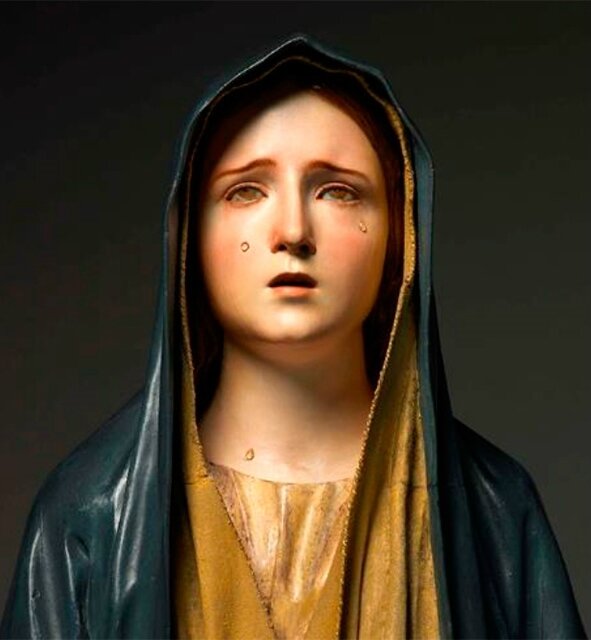Fitzwilliam Museum bids to acquire weeping Virgin by Spanish sculptor Pedro de Mena
Pedro de Mena (1628-1688), The Virgin of Sorrows (Mater Dolorosa), about 1670-5.
CAMBRIDGE.- A remarkably realistic painted wood bust of the Mater Dolorosa (Virgin of Sorrows) by Pedro de Mena (1628-1688), one of the most celebrated sculptors of the Spanish Golden Age, has gone on display at the Fitzwilliam Museum, Cambridge as part of an appeal to acquire the sculpture.
Mesmerisingly beautiful and just under life size at 33.6cm tall, the Virgin of Sorrows’ gently furrowed brows, natural flesh tones, glass eyes and teardrops and eyelashes made from human hair, still elicit a powerful response from the viewer 350 years after it was made. It was most likely created for the private chapel, study or bedchamber of a devout patron, and would almost certainly have been protected under a glass dome and originally paired with a similarly-sized bust of the Ecce Homo (Christ as the Man of Sorrows).
The Virgin of Sorrows is on show in the Museum’s Spanish & Flemish Gallery, alongside other masterpieces by contemporary Baroque sculptors and painters. The Fitzwilliam Museum has already raised a substantial amount towards the work (including £30,000 from the Art Fund and £10,000 from The Henry Moore Foundation) but needs to secure a further £85,000 by the end of September 2014 in order to acquire the remarkable bust.
The Spanish Golden Age, early 16th to late 17th century, was a period of incredible artistic and economic output for Spain, seeing the nation rise to one of the greatest empires the world has ever seen. From the conquest of the New World, to the writing of Don Quixote by Miguel de Cervantes, this period changed the course of world politics and culture. The Fitzwilliam Museum has a small collection of Spanish art, including two works by Bartolomé Esteban Murillo, but the more emotive Catholic works, exemplified by painted wood sculpture are extremely rare in British collections. Taste and religion played their part in this: indeed, most of de Mena’s sculptures remain in the churches, monasteries and convents for which they were made.
The Spanish sculptor Pedro de Mena (1628-1688) was taught the art of wood carving by his father, Alonso de Mena (1587-1646), a well-regarded sculptor of traditional religious images in Granada. Following his father’s death, the eighteen-year-old Pedro took over the workshop and was joined by established artist Alonso Cano (1601-1667), who taught him how to realistically paint sculpture. Cano also encouraged Mena to enhance the naturalism of his sculptures by including additional elements, such as eyes and tears made from glass, and eyelashes from human hair. As such, Mena’s statues and busts have a remarkable lifelike quality, which can be unnerving to the 21st century viewer. Mena left Granada in 1658 and spent the rest of his career in Málaga, becoming increasingly well regarded with prestigious patrons from church and state. Mena was known for his intense faith and was elected by the Inquisition in both Granada and Málaga as a censor of images.
Tim Knox, Director of the Fitzwilliam Museum said: “The thing about this bust is that it is not one of those lugubrious virgins with rolling eyes that one associates with Spanish religious art. Here instead is a strikingly simple, and arrestingly intense, portrait of a beautiful young woman - an Andalusian peasant girl perhaps? - depicted in that moment of hopeless anguish for the humiliation and loss of her only Son. Pedro de Mena's Mater Dolorosa would be a wonderful addition to our collection.”

/https%3A%2F%2Fprofilepics.canalblog.com%2Fprofilepics%2F1%2F0%2F100183.jpg)
/https%3A%2F%2Fstorage.canalblog.com%2F03%2F02%2F119589%2F96711876_o.jpg)
/https%3A%2F%2Fstorage.canalblog.com%2F11%2F31%2F119589%2F94773502_o.jpg)
/https%3A%2F%2Fstorage.canalblog.com%2F20%2F83%2F119589%2F94772815_o.jpg)
/https%3A%2F%2Fstorage.canalblog.com%2F26%2F72%2F119589%2F75604929_o.jpg)
/https%3A%2F%2Fstorage.canalblog.com%2F59%2F60%2F119589%2F26458628_o.jpg)



/image%2F1371349%2F20240418%2Fob_ac5c4c_telechargement.jpg)
/image%2F1371349%2F20240418%2Fob_709b64_304-1.jpg)
/image%2F1371349%2F20240418%2Fob_22f67e_303-1.jpg)
/image%2F1371349%2F20240417%2Fob_9708e8_telechargement.jpg)